Model Test and Numerical Simulation of Single Pile Response under Combined Loading in Slope
Abstract
1. Introduction
2. Model Test
2.1. Pile and Soil Model
2.2. Test Apparatus
2.3. Experimental Process
3. Test Results Analysis
3.1. Displacement and Horizontal Load
3.2. Bending Moment of the Pile
4. 3D FEM Formulation
4.1. Numerical Model Size
4.2. Model Establishment
5. 3D FEM Analysis
5.1. Analysis of Test Results and Finite Element Results
5.2. Distribution of the Earth Pressure
5.3. Displacement of Piles under Different Slopes
5.4. Bending Moment of Piles under Different Slopes
6. Discussion
6.1. Variation of Soil Pressure around the Pile with Depth
6.2. Different Slope Gradients Affect the Internal Force and Displacement
7. Conclusions
Author Contributions
Funding
Acknowledgments
Conflicts of Interest
References
- Ito, T.; Matsui, T.; Hong, W.P. Design method for stabilizing piles against landslide-one row of piles. Soils Found. 1981, 21, 21–37. [Google Scholar] [CrossRef]
- Poulos, H.G. Design of reinforcing piles to increase slope stability. Can. Geotech J. 1995, 32, 8–18. [Google Scholar] [CrossRef]
- Chow, Y.K. Analysis of piles used for slope stabilization. Int. J. Numer. Anal. Meth. Geomech. 1996, 20, 635–646. [Google Scholar] [CrossRef]
- Cai, F.; Ugai, K. Response of flexible piles under laterally linear movement of the sliding layer in landslides. Can. Geotech. J. 2003, 40, 46–53. [Google Scholar] [CrossRef]
- Ahmadi, S.F.; Eskandari, M. Vibration analysis of a rigid circular disk embedded in a transversely isotropic solid. J. Eng. Mech. 2014, 140, 04014048. [Google Scholar] [CrossRef]
- Ahmadi, S.F.; Eskandari, M. Axisymmetric circular indentation of a half-space reinforced by a buried elastic thin film. Math. Mech. Solids 2014, 19, 703–712. [Google Scholar] [CrossRef]
- Zhang, Z.Q.; Pan, E. Vertical vibration of a rigid circular disc embedded in a transversely isotropic and layered poroelastic half-space. Eng. Anal. Bound. Elem. 2020, 118, 84–95. [Google Scholar] [CrossRef]
- Dong, J.; Zhong, S.; Wang, H.L.; Wu, Z.H. Dynamic response characteristics of crossing tunnels under heavy-haul train loads. Geomech. Eng. 2020, 20, 103–112. [Google Scholar] [CrossRef]
- Liu, J.H.; Zhao, M.H.; Yang, M.H. Model tests on bridge pile foundation in high and steep rock slopes. Chin. J. Geotech. Eng. 2009, 31, 372–377. [Google Scholar]
- Broms, B.B. Lateral resistance of piles in cohesionless soils. J. Soil Mech. Found. Eng. Div. ASCE 1964, 90, 123–156. [Google Scholar]
- Randolph, M.F. The response of flexible piles to lateral loading. Geotechnique 1981, 31, 247–259. [Google Scholar] [CrossRef]
- Fan, C.C.; Long, J.H. Assessment of exiting methods for predicting soil response of laterally loaded piles in sand. Comput. Geotech. 2005, 32, 274–289. [Google Scholar] [CrossRef]
- Chik, Z.; Abbas, J.; Taha, M.; Shafiqu, Q.S.M. Lateral behavior of single pile in cohesionless soil subjected to both vertical and horizontal loads. Eur. J. Sci. Res. 2009, 29, 194–205. [Google Scholar]
- Comodromos, E.M.; Papadopoulou, M.C.; Laloui, L. Contribution to the design methodologies of piled raft foundations under combined loadings. Can. Geotech. J. 2016, 53, 559–577. [Google Scholar] [CrossRef]
- Begum, N.A.; Muthukkumaran, K. Experimental investigation on single model pile in sloping ground under lateral load. Int. J. Geotech. Eng. 2009, 3, 133–146. [Google Scholar] [CrossRef]
- Chien, C.J.; Lin, S.S.; Yang, C.C.; Liao, J.C. Lateral performance of drilled shafts due to combined lateral and axial loading. J. Mech. 2013, 29, 685–693. [Google Scholar] [CrossRef]
- Xie, J.M.; Xu, X.C.; Chen, S.X.; Jian, L.F. Experimental study on horizontal bearing deformation of slope pile foundation. Sci. Technol. Eng. 2013, 13, 5031–5036. [Google Scholar]
- Zhang, J.W.; Kong, M.; Ma, J.D. Study on bearing capacity of the single pile on slope under complex loads. Build. Struct. 2014, 8, 96–99. [Google Scholar]
- Kershaw, K.A.; Luna, R. Full-scale field testing of micropiles in stiff clay subjected to combined axial and lateral loads. J. Geotech. Geoenviron. Eng. 2014, 140, 255–261. [Google Scholar] [CrossRef]
- Zuo, D.J.; Chen, L.; Tian, Z.W.; Qi, C.G. Numerical study on mechanical characteristics of pile groups of wharf foundation under lateral and vertical cyclic loadings. Chin. J. Geotech. Eng. 2015, 37, 51–56. [Google Scholar]
- Muthukkumaran, K.; Begum, N.A. Experimental Investigation of Single Model Pile Subjected to Lateral Loading Sloping Ground. Geotech. Geol. Eng. 2015, 33, 935–946. [Google Scholar] [CrossRef]
- Jegatheeswaran, B.; Muthukkumaran, K. Behavior of pile due to combined loading with lateral soil movement. Int. J. Geo Eng. 2016, 7, 8. [Google Scholar] [CrossRef][Green Version]
- Matlock, H. Correlations for design of laterally loaded piles in soft clay. In Proceedings of the 2nd Offshore Technology Conference, Houston, TX, USA, 22–24 April 1970; British Maritime Technology: Teddington, UK, 1970; Volume 1, pp. 577–594. [Google Scholar]
- Rao, S.N.; Ramakrishna, V.T.; Balarama, G. Behavior of pile supported dolphins in marine clay under lateral loading. J. Geotech. Eng. 1996, 122, 607–612. [Google Scholar] [CrossRef]
- Rao, S.N.; Ramakrishna, V.T.; Babu, M. Influence of rigidity on laterally loaded pile groups in marine clay. J. Geotech. Geoenviron. Eng. 1998, 124, 542–549. [Google Scholar] [CrossRef]
- Wang, H.; Lv, Z.; Zhang, J.; Yue, J.; Qin, H.; Hung, C. Internal Force Analysis of Buried-boring Piles in the Yuanzishan Landslide. Appl. Sci. 2020, 10, 5416. [Google Scholar] [CrossRef]
- Kim, Y.H.; Jeong, S.S. Analysis of soil resistance on laterally loaded piles based on 3D soil-pile interaction. Comput. Geotech. 2011, 38, 248–257. [Google Scholar] [CrossRef]
- Xu, L.Y.; Pan, J.M.; Xue, Y.Y.; Cai, F.F. A Numerical Investigation of Influence of Low-Plasticity Fines in Sand on Lateral Response of Piles. Mar. Geores. Geotech. 2019, 38, 302–311. [Google Scholar] [CrossRef]
- Guo, W.; Qin, H. Thrust and bending moment of rigid piles subjected to moving soil. Can. Geotech. J. 2010, 47, 180–196. [Google Scholar] [CrossRef]
- Standardization Administration of China. JGJ 94-2008: Technical Code for Building Pile Foundations; Standardization Administration of China: Beijing, China, 2008. (In Chinese) [Google Scholar]
- Tang, H.; Hu, X.; Xu, C.; Li, C.; Yong, R.; Wang, L. A novel approach for determining landslide pushing force based on landslide-pile interactions. Eng. Geol. 2014, 182, 15–24. [Google Scholar] [CrossRef]
- Qin, H.; Guo, W. Response of piles subjected to progressive soil movement. Geotech. Test. J. 2016, 39, 106–125. [Google Scholar] [CrossRef]
- Wang, H.; Wang, P.; Qin, H.Y. Method to Control the Deformation of Anti-Slide Piles in Zhenzilin Landslide. Appl. Sci. 2020, 10, 2831. [Google Scholar] [CrossRef]
- Wang, H.; Lv, Z.Y.; Qin, H.Y. Deformation Control Method of the Antislide Pile under Trapezoidal Load in the Zhangjiawan Landslide. Adv. Civil Eng. 2020, 2020, 1405610. [Google Scholar] [CrossRef]
- Stacul, S.; Squeglia, N.; Morelli, F. Laterally Loaded Single Pile Response Considering the Influence of Suction and Non-Linear Behaviour of Reinforced Concrete Sections. Appl. Sci. 2017, 7, 1310. [Google Scholar] [CrossRef]
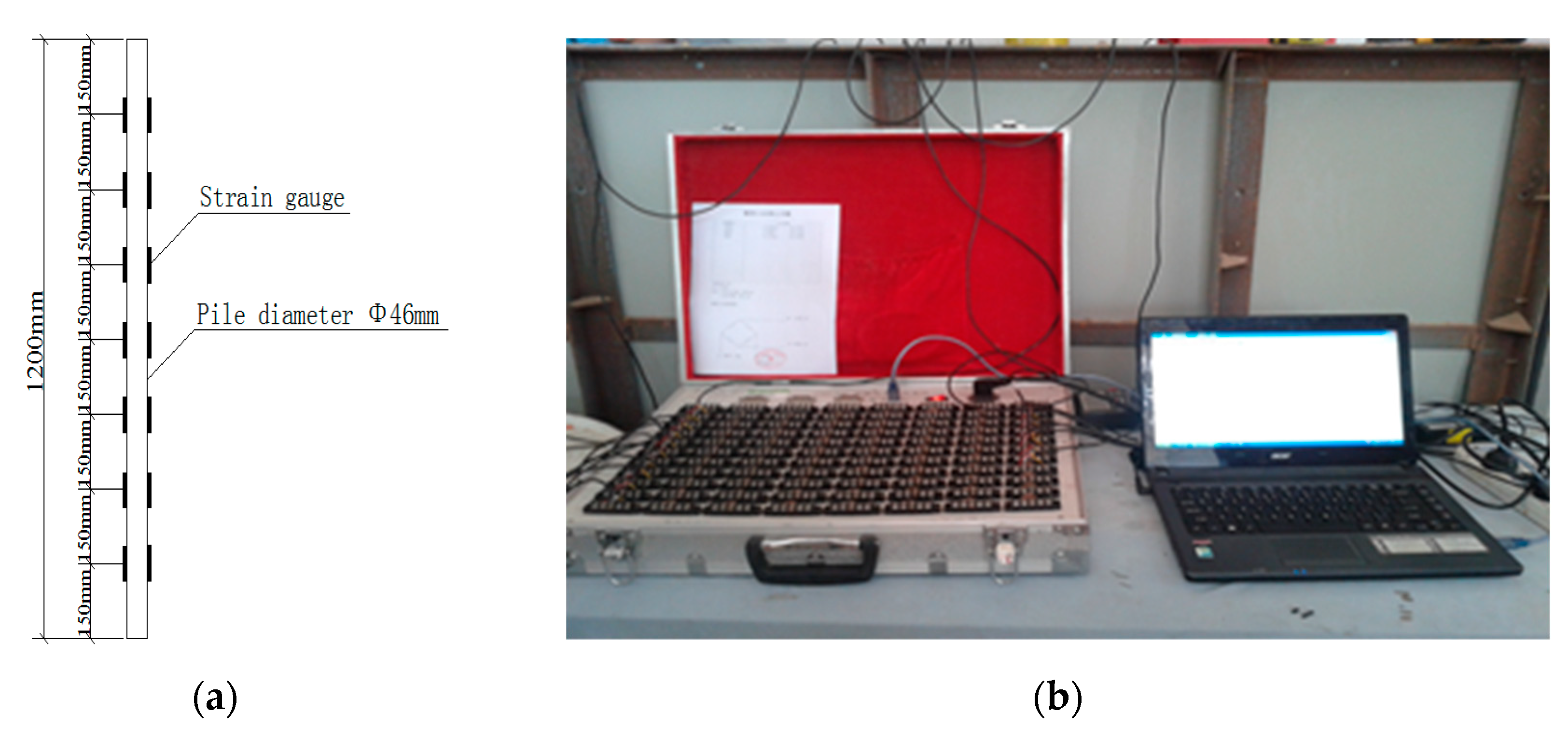
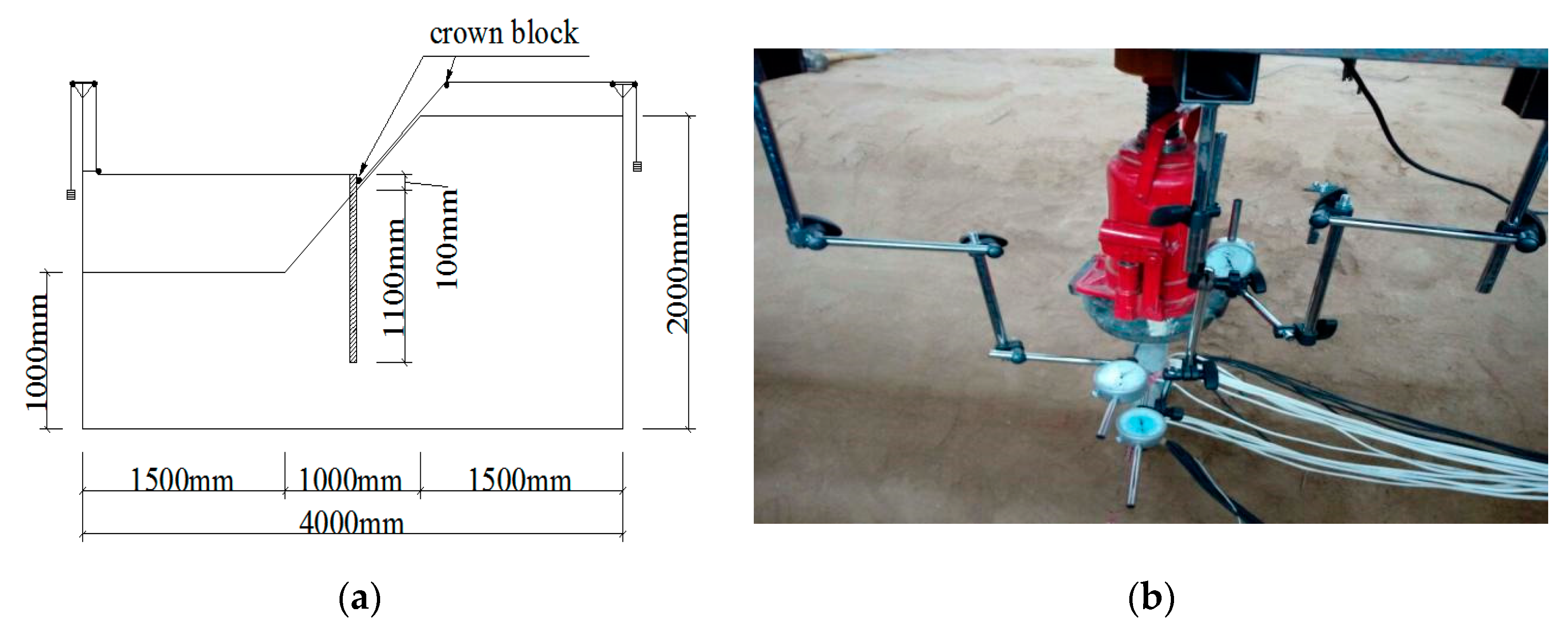
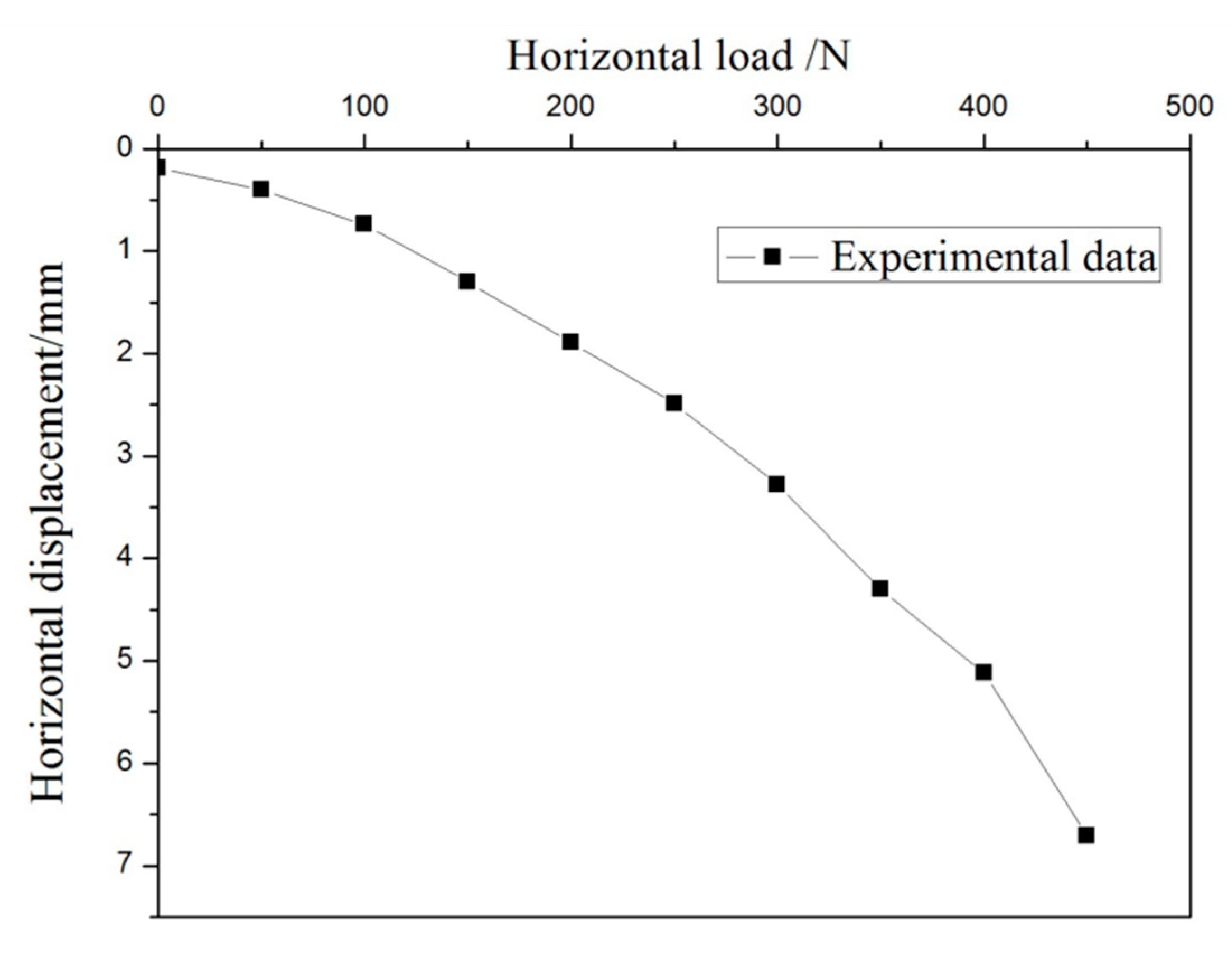
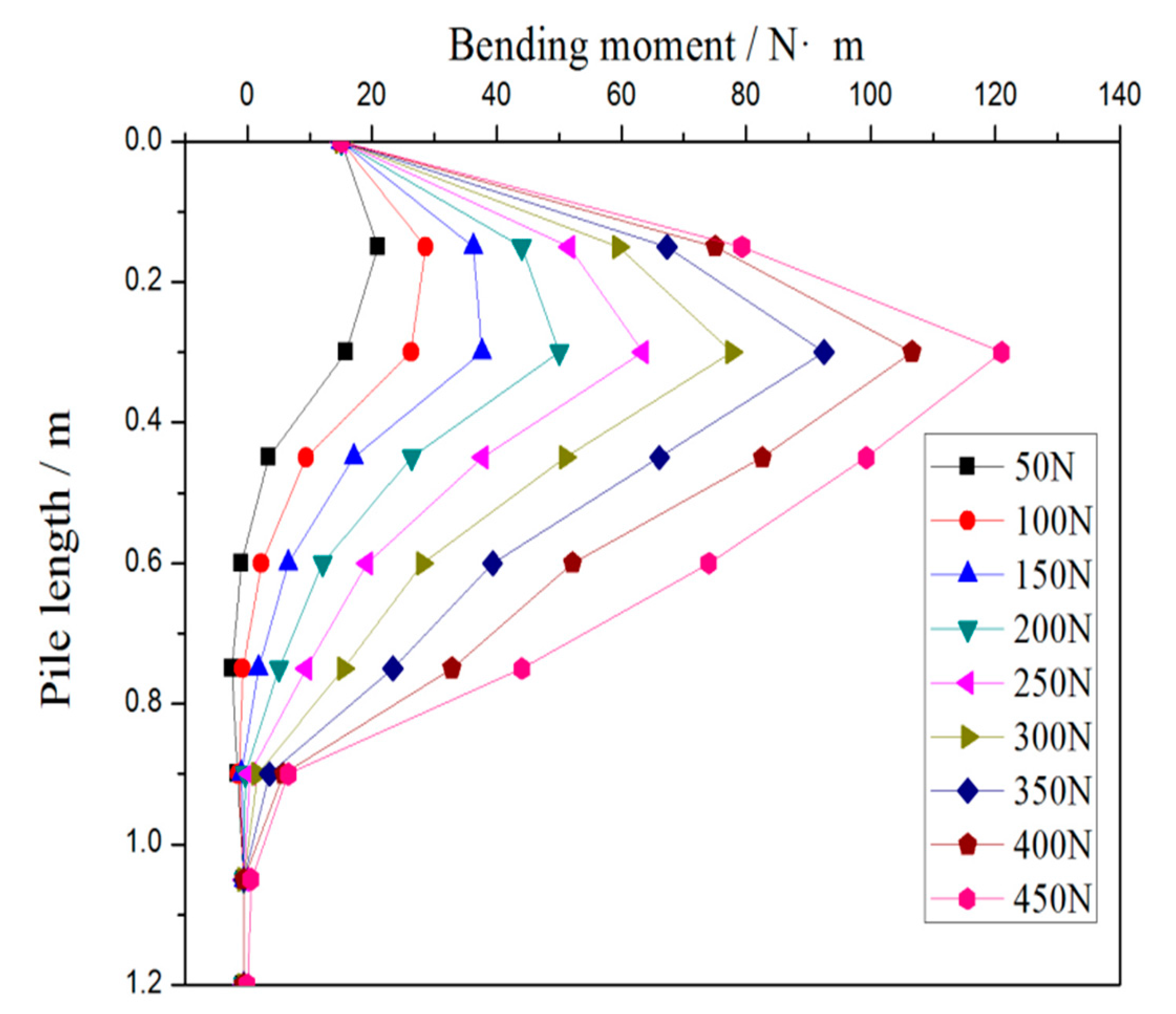


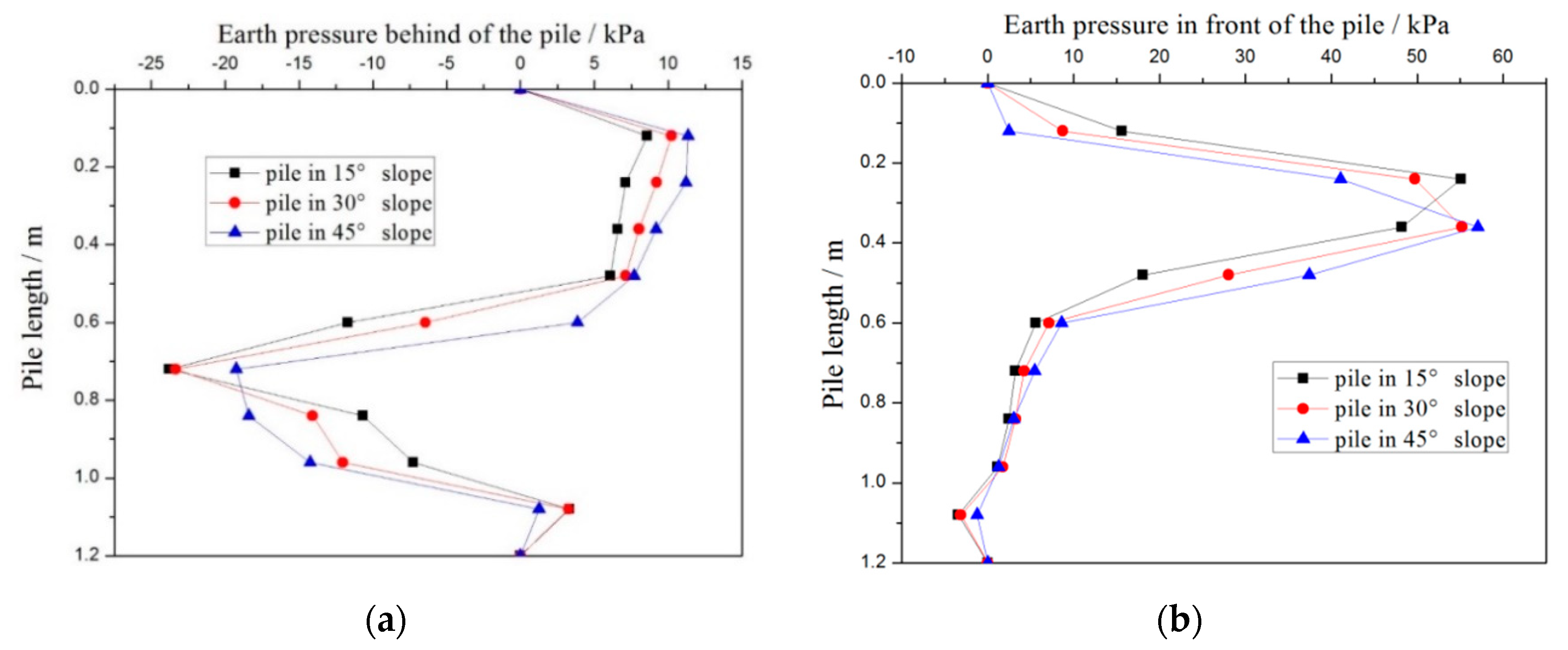
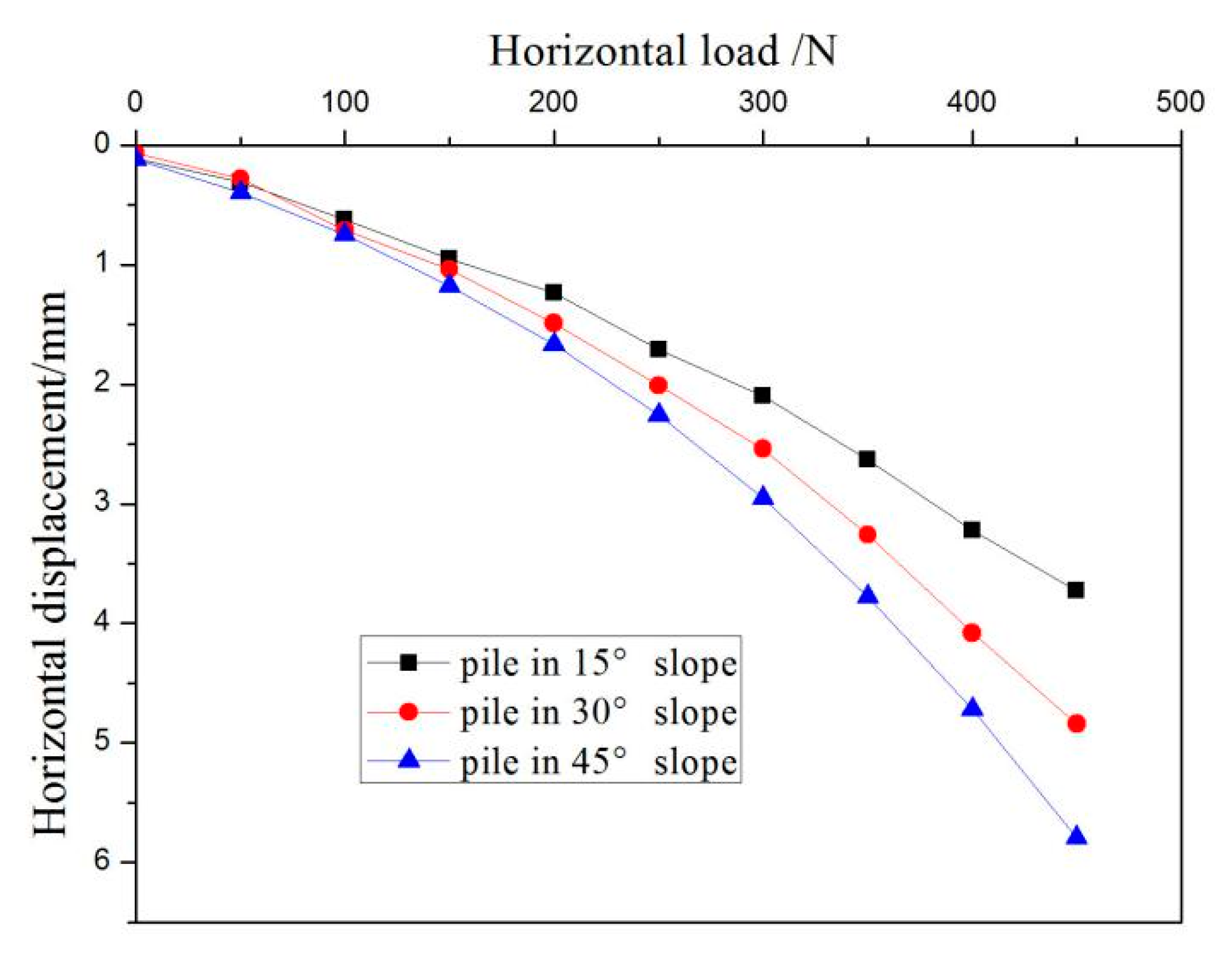
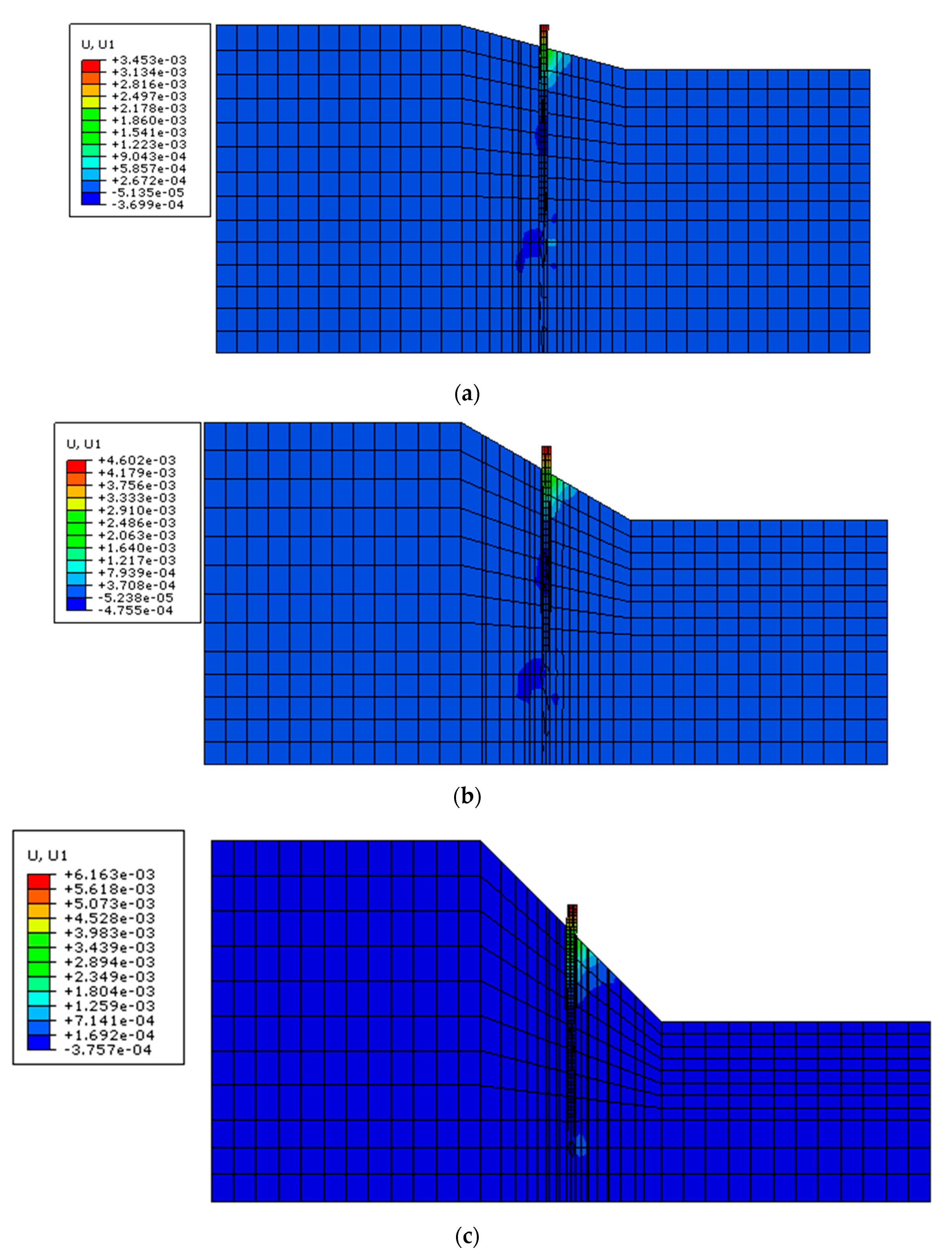
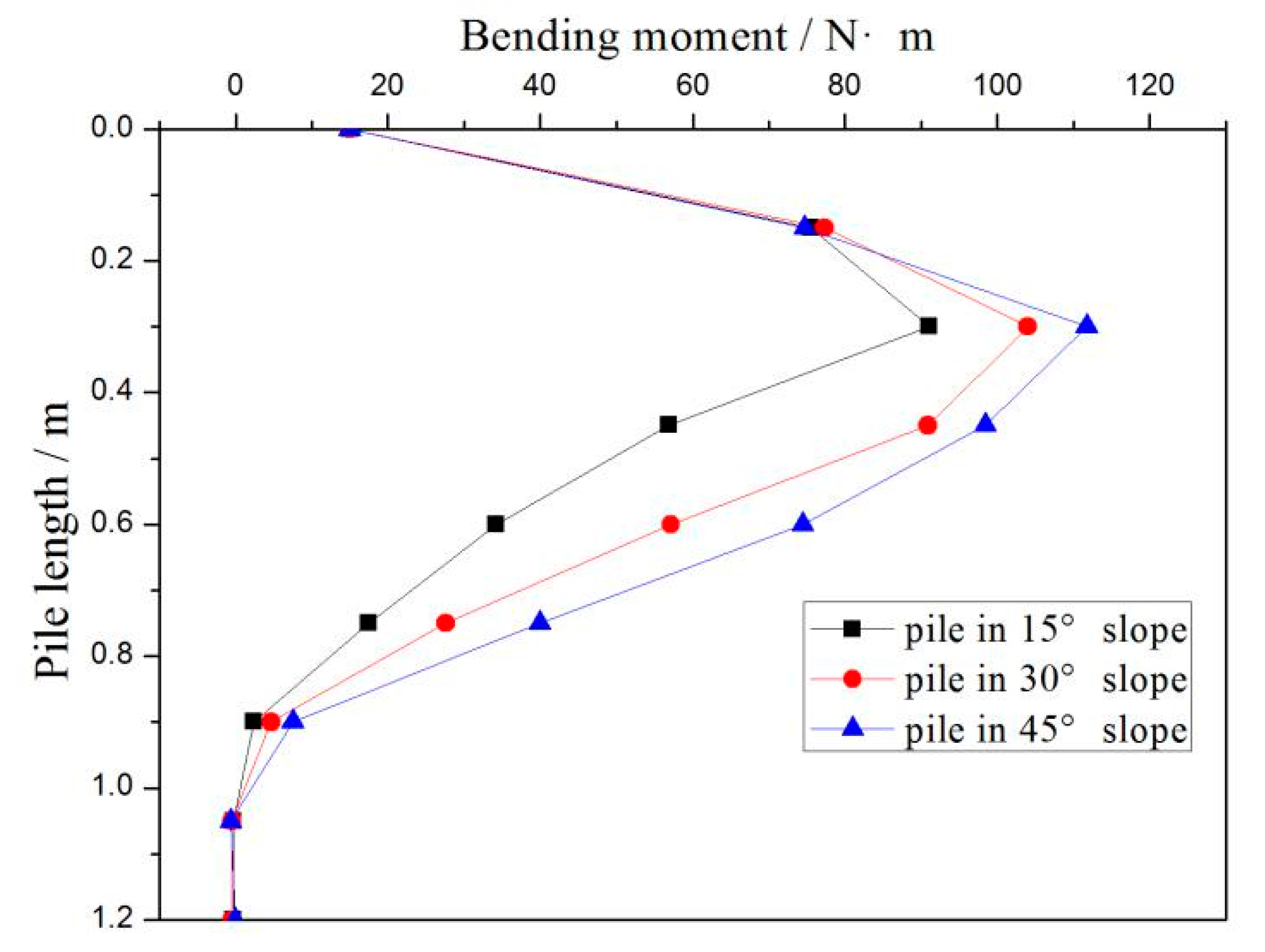
| Density/ ρ(g/cm3) | Cohesion/c(kPa) | Modulus/Es(MPa) | Moisture Content/w(%) | Internal Friction Angle/φ(°) |
|---|---|---|---|---|
| 1.95 | 4.3 | 12.5 | 5.4 | 32 |
| Elastic Modulus/(GPa) | Poisson’s Ratio/v | Pile Diameter/d(m) | Density/ρ(g/cm3) | Pile Length/L(m) |
|---|---|---|---|---|
| 20 | 0.12 | 0.05 | 2.40 | 1.2 |
© 2020 by the authors. Licensee MDPI, Basel, Switzerland. This article is an open access article distributed under the terms and conditions of the Creative Commons Attribution (CC BY) license (http://creativecommons.org/licenses/by/4.0/).
Share and Cite
Zhang, J.; Wang, X.; Wang, H.; Qin, H. Model Test and Numerical Simulation of Single Pile Response under Combined Loading in Slope. Appl. Sci. 2020, 10, 6140. https://doi.org/10.3390/app10176140
Zhang J, Wang X, Wang H, Qin H. Model Test and Numerical Simulation of Single Pile Response under Combined Loading in Slope. Applied Sciences. 2020; 10(17):6140. https://doi.org/10.3390/app10176140
Chicago/Turabian StyleZhang, Jianwei, Xiaoju Wang, Hao Wang, and Hongyu Qin. 2020. "Model Test and Numerical Simulation of Single Pile Response under Combined Loading in Slope" Applied Sciences 10, no. 17: 6140. https://doi.org/10.3390/app10176140
APA StyleZhang, J., Wang, X., Wang, H., & Qin, H. (2020). Model Test and Numerical Simulation of Single Pile Response under Combined Loading in Slope. Applied Sciences, 10(17), 6140. https://doi.org/10.3390/app10176140





